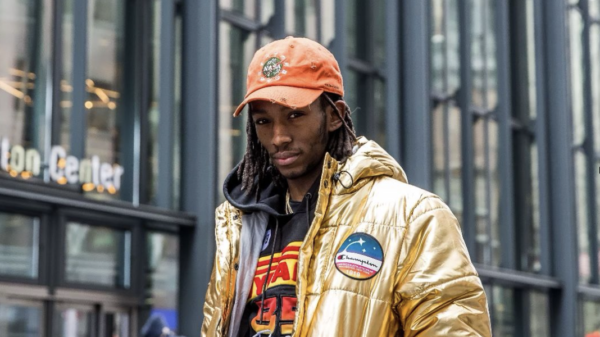Among the brilliant first four Talking Heads albums, More Songs About Buildings and Food has always been a dark horse candidate for the all-around greatest. Released 47 years ago this month, it sounds more electable now than ever. With its lean muscularity, panic-attack propulsion, weird ambiance, highwire anxiety, paranoid prescience and formal coherence, it comes across as the Sgt. Pepper of media-age alienation.
That alone would merit a shout-out for More Songs About Buildings and Food (Super Deluxe Edition), yet another super-sized major label classic album vault-scraping. But there’s context, too. The run-up to the band’s half-century birthday — they formed in 1975 — has seen the theatrical re-release of Jonathan’s Demme’s touchstone concert doc Stop Making Sense (spurring a Heads reunion, at least on talk-show couches). Head Head David Byrne reanimated the band’s catalog on Broadway and film via the American Utopia project. Drummer Chris Frantz wrote an excellent memoir (Remain in Love). Heads vets Jerry Harrison and Adrian Belew are currently touring a band (call ‘em Heads & Company) focused on material from the band’s 1980 classic Remain In Light–era, while lesser-known tribute acts — see Mystic Bowie’s Talking Dreads — have spiced up the cover band circuit for years.
Part of the magic of More Songs is about the addition of Harrison, fresh off his tenure with Velvet Underground acolytes The Modern Lovers, on second guitar and keyboards, bolstering the original trio of Byrne, Frantz, and bassist Tina Weymouth. More magic came from co-producer Brian Eno, currently in the midst of his own latter-day renaissance (recently, two collaborative LPs with Beatie Wolf and a perpetually-shapeshifting career documentary, Eno). More Songs was the band’s initial studio encounter with the future super-producer (Fear of Music and Remain in Light followed). Like a good first date, there’s a sense of discovery and mutual admiration, everyone showing their best selves, letting each other shine — the high-strung art-schooled NYC post-punks and the low-key art-schooled post-glam English groove scientist.
Editor’s picks
Eno’s influence is subtle but key. You notice it on the rag-tag chorus of “The Good Thing,” with its Before and After Science vibe. It’s delivered by a choir dubbed “Tina and the Typing Pool” in the liner notes, which included support staffers at Compass Point Studios, then a brand-new state-of-the-art facility built in the Bahamas by Chris Blackwell of Island Records. More Songs was among the first albums recorded there, helping to map the dubby club grooves of the ‘80s and make the studio a recording destination. (Tina Weymouth recalled the band got an early-bird discount; one of the two studio rooms was still under construction.)
You also feel Eno’s presence in the rubbery snare hits and nagging car-alarm guitar riff of “Warning Sign” — a song whose foreboding vibe hits particularly hard in 2025. More Songs is, in effect, Eno’s debut as a capital-P producer, notwithstanding some minor early efforts and, of course, David Bowie’s landmark sessions for Low and Heroes. Eno didn’t co-produce those albums per se, though he shaped them by “treating” instruments via his EMS Synthi AKS portable synth. He worked in a similar way on More Songs (In the new liner notes, Byrne recalls “we asked for the Low snare effect […] so we got that on “Take Me To The River,” as well as some sonar sounds that Brian added.”)
The album’s closer, “Big Country,” also lands hard in 2025 — a travelogue survey of a land mass, presumably North America, that zooms in on every-day life on the ground and concludes “I wouldn’t live there if you paid me to,” followed by an outburst of gibberish and distinctly country-western guitar licks. An alternate take of the album’s opening track, “Thank You for Sending Me an Angel (Country Angel Version),” amplifies the concept, magnifying the song’s trail-ride rhythm and adding caffeinated campfire acoustic guitar strums. More Songs About Buildings and Food has always been one of the great concept albums about America. As Jonathan Gould notes in his new band bio, Burning Down The House, the LP was originally titled Oh What a Big Country, before Chris and Tina (with help from XTC’s Andy Partridge) hit on a better idea. Fittingly, the music is intense, darkly funny, frequently beautiful, absurd, sometimes frightening, belligerent, angry, crazy.
Trending Stories
Related Content
There’s nothing earthshaking among the bonus cuts (10 alternate takes plus an instrumental version of Fear of Music’s “Electricty”). But they do shine light on process. You hear how the tempo of “Artists Only” got sped up, how “Girls Want to Be With the Girls” was slowed down. (“Take Me to the River” was also slowed down, radically, from the band’s early live versions, though there’s no studio evidence here.) The instruments are more clearly defined on the alternates, before, one assumes, Eno artfully smeared the final takes. His touches made all the difference, however, pulling the songs into a pulsing turbo-charged whole. Side two of the finished LP, in particular, was one of the great house party soundtracks of the era.
That version of Talking Heads, the house party dance band, gets showcased here in a cleaned up copy of a widely-circulated concert bootleg, recorded in the summer of 1978 in New York at the short-lived Entermedia Theater — formerly the Yiddish Art Theater, built in the gilded-age ‘20s and, like everything else in the late-‘70s, a bit down at the heel, a very-off-Broadway Lower East Side venue that was just a short walk from the band’s early home base of CBGB. On this night, they were a killer bar band with a sophomore record, grown from trio to quartet, breaking into full bloom, and already showcasing new material (“Drugs”) that would be on their stranger, more diffuse follow-up. Byrne camps up the vocals, hooting, hollering, snarling, yelping and whooping; Harrison thickens the guitar mix; Tina and Chris drive the rhythm; and songs tumble one into the next like a great, sweaty-ass DJ set. Quite a moment, but they were all just getting started.





























